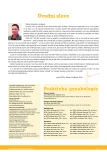– mature sperm selection for human oocyte fertilization by ICSI method
Authors:
J. Žáková; E. Lousová; I. Crha; P. Ventruba; M. Pohanka; P. Nentwichová; H. Pochopová
Authors‘ workplace:
Gynekologicko–porodnická klinika LF MU a FN Brno
Published in:
Prakt Gyn 2010; 14(4): 180-182
Category:
Original Article
Overview
Aim of the study:
PICSI (preselected intracytoplasmic sperm injection) utilizes the ability of mature sperm to bind to hyaluronan to select mature sperm for oocyte fertilisation by ICSI (intracytoplasmic sperm injection). It is only the mature sperm head that has a receptor for this specific attachment. The aim of this study was to determine whether PICSI increases treatment success.
Material and methods:
Special PICSI dishes (PICSI® Sperm Selection Device MidAtlantic Diagnostics, Inc.) with three microdrops of hyaluronan at the bottom were used for sperm selection. During incubation, mature spermatozoa bound to the hyaluronan layer. Micromanipulation pipettes were used to collect bound sperms and these sperms were used for ICSI.
Results:
PICSI was used for mature sperm selection in 40 couples. Fertilization rate was 93.4% compared to our centre‘s standard (no sperm selection) ICSI long-term results of 89.2%. Thirty eight embryotransfers resulted in 21 clinical pregnancies (pregnancy rate 55.3%) compared to our centre’s standard ICSI long-term results of 38.2%.
Conclusion:
PICSI appears to be a useful method for improving ICSI results.
Key words:
PICSI – ICSI – spermatozoon – infertility – hyaluronan
Sources
1. Huszar G, Ozenci CC, Cayli S et al.Hyaluronic acid binding by hunman sperm indicates cellular maturity, viability, and unreacted acrosomal status. Fertil Steril 2003; 79(3): 1616–1624.
2. Jakab A, Sakkas D, Delpiano E et al. Intracytoplasmic sperm injection: a novel selection method for sperm with normal frequency of chromosomal aneuploides. Fertil Steril 2005; 84(6): 1665–1673.
3. World Health Organization. Laboratory Manual for the Examination of Human Semen and Sperm-Cervical Mucus Interaction. 4th edn. Cambridge University Press, 1999.
4. Cayli S, Sakkas D, Vigue L et al. Cellular maturity and apoptosis in human sperm: creatine kinase, caspase-3 and Bclx expresion in mature and diminished maturity spermatozoa. Mol Hum Reprod 2004; 10: 365–372.
5. Huszar G, Vigue L. Incomplete development of human spermatozoa is associated with incerased creatine pjosphokinase concentration and abnormal head morphology. Mol Reprod Dev 1993; 34: 292–298.
6. Crha I, Kralikova M, Melounova J. et al. Seminal plasma homocysteine, folate and cobalamin in men with obstructive and non-obstructive azoospermia. J Assist Reprod Genet, 2010; 27: 533–538.
7. Oborna I, Wojewodka G, De Sanctis JB et al. Increased lipid peroxidation and abnormal fatty acid profiles in seminal and blood plasma of normozoospermic males from infertile couples. Hum Reprod 2010; 25: 308–316.
Labels
Paediatric gynaecology Gynaecology and obstetrics Reproduction medicineArticle was published in
Practical Gynecology

2010 Issue 4
Most read in this issue
- Date rape
- The effect of tadalafil treatment on sperm count in men with erectile dysfunction
- The impact of uterine fibroids on reproductive function
- Sexual life in pregnancy – assessment by the SFW questionaire (Sexual Function of a Woman)
